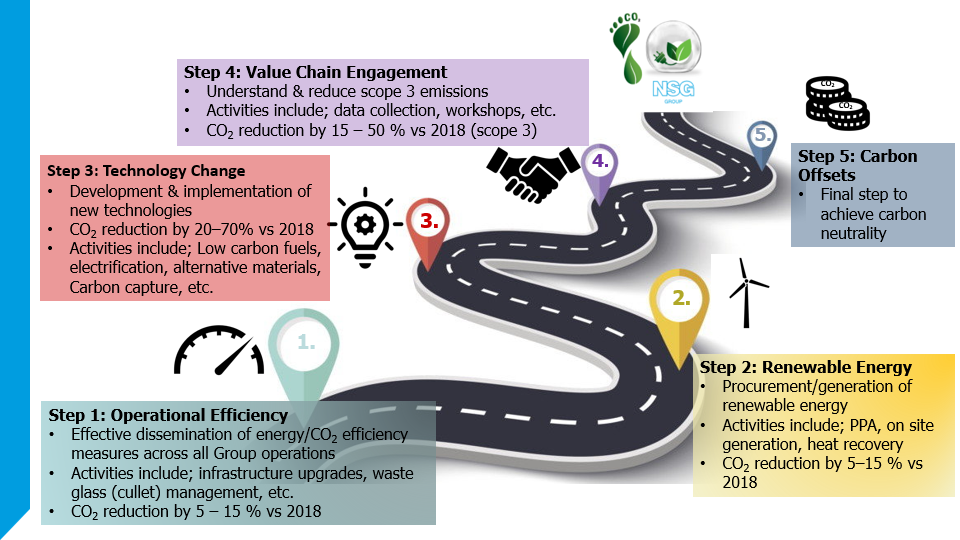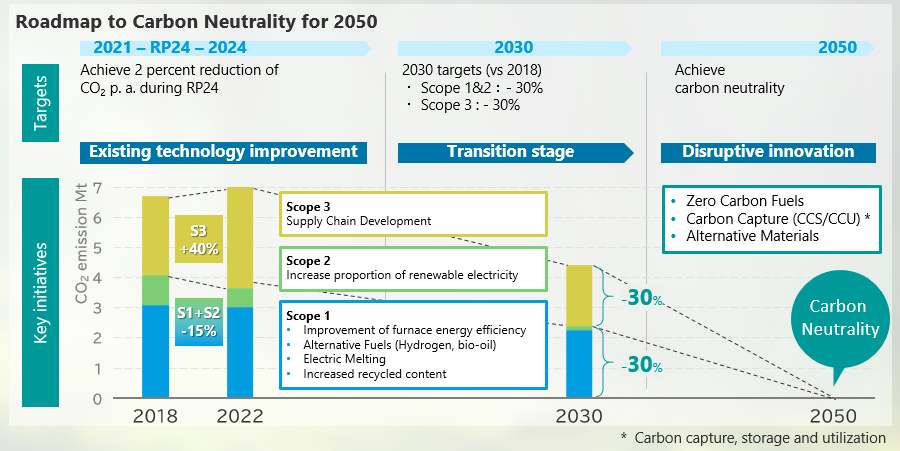|
TCFD Recommendation
- Describe the metrics used by the organization to assess climate related risks and opportunities in line with its strategy and risk management process
NSG Group Approach
- NSG Group monitors all GHG emissions across the supply chain (scope 3), own operations (scope 1 & 2) and customer impacts (scope 3). The primary metric tracked is absolute tonnes of CO2 emissions across these three emission scopes. Supplier sustainability impacts are also tracked using software tools such as the EcoVadis platform. Future predictions of the GHG emissions are used to estimate the impact of the various actions for GHG emission mitigation, with a hierarchal approach of these actions to ensure investment and implementation is optimized according to the strategic risk and opportunity for each action and overall impact to the Group goals and targets.
- These actions are incorporated into the NSG decarbonization roadmap at company and local (e.g. manufacturing site) level.
- In 2022 the NSG Group linked three climate change impact KPIs to a loan agreement in the form of a sustainability linked loan. The three KPIs chosen are absolute CO2 emission (scope 1 & scope 2), % renewable electricity and supply chain performance measured via EcoVadis. These KPIs were selected as they represent key areas of the NSG strategy to support decarbonization.
Further Disclosure / Information sources
https://www.nsg.com/en/sustainability/sustainability-of-nsg-group/target-and-results
|
|
TCFD Recommendation
- Disclose scope 1, scope 2 and if appropriate scope 3 greenhouse gas (GHG) emissions and the related risks
NSG Group Approach
- CO2 emissions in the baseline year for the NSG Group SBT were as follows.
- In the latest report year (CY2023) the emissions across the three scopes were as follows.
- In addition, the trend in CO2 emission from 2018 to 2023 is as follows.
- The RP24 MTP target of reducing greenhouse gas emissions per unit of production in the glass manufacturing process by 8% by FY2024/3 compared to FY2018/3 was achieved. The FY2024/3 performance was 5.5% better than in FY2023/3 and 8% better than in FY2018/3
- Good progress continues to be made towards the Groups commitment for increasing the proportion of renewable electricity consumption across the operations. In CY2023 the proportion of renewable electricity reached a level of 35% (CY2022 was 32%). The company remains on track to deliver the challenging CY2024 target of 50%. This target also continues within the Group new MTP, with a target of 65% renewable electricity proportion by end of FY2027.
- We are also committed to achieving carbon neutrality by 2050. This is in line with the Group's mission "Building a better world by creating comfortable living spaces", as well as meeting the demands of our customers and investors and the expectations of our employees. The roadmap set out below is embedded as an action plan at company-wide level and at local level, e.g. at production sites. The implementation of this roadmap will lead to a reduction in CO2 emissions and, in turn, to the continuous development of Sustainability and products and the expansion of opportunities related to our business.

Further Disclosure / Information sources
CDP report 2023 C4.1 - 4.2
|
|
TCFD Recommendation
- Describe the targets used by the organization to manage climate related risks and opportunities and performance against targets
NSG Group Approach
- The NSG Group established a SBT verified in 2019. This target was a 21% reduction in absolute CO2 emissions across Scope 1 and Scope 2.
- SBTi is a partnership between CDP (former Carbon Disclosure Project), UN Global Compact, WRI (World Resources Institute) and WWF (World Wildlife Fund), which helps companies set the science-based goals for reducing GHG emissions to prevent the impact of climate change.
- In 2021, the NSG Group evaluated this target and took the decision to increase the level of ambition for this target in terms of the level of reduction and emission scopes included, as well as the introduction of a formal commitment to achieve carbon neutrality.
- This revised target was verified by the SBTi in May 2022. The target is a 30% reduction in absolute CO2 emissions across Scope 1 + Scope 2 and Scope 3 to be achieved by 2030 (vs a 2018 baseline).
- A 1.5℃ scenario is the preferred target setting, but this requires a significant reduction (halving) of our Scope 1 emissions, which account for nearly half of our CO2 emissions. As our Scope 1 emissions are generated by the combustion of fossil fuels in the glass melting process, we need to switch to fuels from renewable energy sources in order to reduce our Scope 1 emissions. The technology development required for fuel conversion is progressing and does not require significant capital investment, but we do not expect to be able to supply the amount of green fuels we need until 2030 or later. The target is therefore set for a scenario well below 2℃, rather than the 1.5℃ scenario. This target was approved by the SBTi in May 2022 in FY2023/3.
- 2023 performance against this revised target has been challenging due to several aspects associated with the absolute reduction nature of this target;
- Economic recovery post Covid19 pandemic has resulted in increased production output of products
- NSG Group continues to invest in new operational assets, with the establishment of a new production facility in the USA (Luckey) and in Argentina (Cardales)
- Customer demand for high performance glazing products to support the low carbon transition, e.g. high thermal performance glazing results in a higher embodied carbon content of the product in it's manufacture.
- Increased analysis and understanding of emission impacts, especially Scope 3 emissions has resulted in an increase in the level of emissions reported.
- These 'negative' aspects have been offset by the ongoing program of activities to reduce operational CO2 emissions across the NSG Group. These activities include;
- Continued implementation of operational efficiency improvement measures
- Increased proportion of electricity from certified renewable generation sources
- Implementation of R&D trials in specific aspects of decarbonization technologies, e.g. the use of alternative fuel technologies.
- Moving forwards, the implementation of the NSG decarbonization roadmap will overcome the 'negative' market aspects leading to a reduction in absolute CO2 emissions whilst maximizing the opportunities associated with continued development of carbon saving products and expansion of NSG operations. For more details, please refer to "Roadmap to Carbon Neutrality".

Further Disclosure / Information sources
CDP report 2023 C4.3
https://www.nsg.com/en/sustainability/sustainability-of-nsg-group/climate-change/reducing-CO2-emissions
|